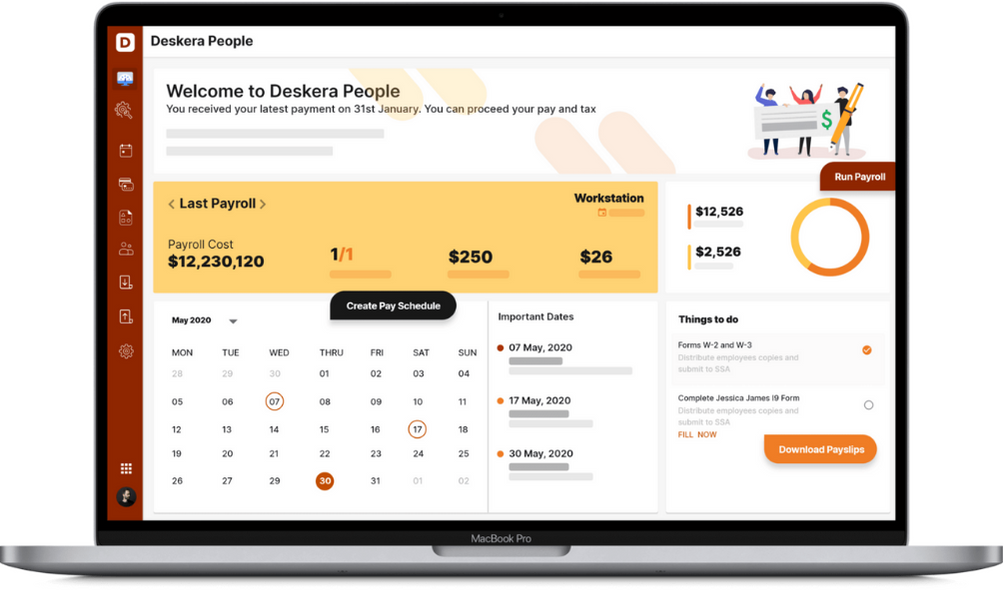91.4% of people in the United States covered under Health Insurance have changed the landscape of employee benefits. The introduction of new initiatives and options in the healthcare benefits have transformed the escalating cost of healthcare and other related benefits under the regulation of the Affordable Care Act(ACA).
As a result, the role of employers has buckled up in exploring the ways to manage the cost of health coverage portions and their respective contributions to the employee's overall benefit programs.
In this article, we will discuss the role and contribution of employers toward the health insurance plan for their employees along with the following:
• Background of Health Care Insurance in the U.S.
• What are the Affordable Care Act requirements?
• What percentage of health insurance should an employer have to contribute?
• What's the breakdown of employer contribution?
• What are ways in which contributions to health insurance premiums are taxed?
• What is the role of QSEHRA's contribution to health insurance?
Background of Health Care Insurance in the U.S.
In the United States, healthcare insurance is covered as a significant benefit of employment. The U.S. Internal Revenue Code places employers and employees under twin benefits. First, employers can deliver healthcare benefits to employees as a tax-deductible cost of the business, and in return, employees can receive these benefits free of tax.
But as mentioned above, since there is a rise in the price of health care costs, employers are looking forward to planning these medical expenses for their employees by adjusting and reassessing their roles as providers.
As per the trends, employers are looking forward to integrating the cost of Health insurance between them and employees such that it becomes easy to handle on both sides.
The employers can choose a Health Insurance plan and determine the amount they would like to cover. For example, they might cover 80%, and the rest can be the responsibility of the employees to pay for the plan's cost.
This plan helps to balance out and implement these wellness programs to improve the employee's health and reduce the health cost over the long term. In addition, the Affordable Care Act plays a vital role in affecting the role of employers in providing healthcare coverage and managing the costs for their employees.
What are the Affordable Care Act's requirements?
As per the Affordable Care Act, employers with 50 or more employees need to offer healthcare plans and benefits that meet a minimum value standard.
In this case, the employers should provide health insurance to every individual working under them. In addition, the plan should be economical, comprehensive, and cover at least 60% of their employee's medical care.
The employer should make sure that the health care plan should also have physician and inpatient hospital services coverage.
All of these ACA requirements mentioned above come under a "qualified health plan" or a "minimum essential coverage" that includes
- essential healthcare benefits
- Limited cost-sharing by an employee
What percentage of health insurance should an employer have to contribute?
According to the insurance carriers, the employer's percentage of healthcare contributions for the employee's group health insurance plan. Under insurance carriers, the company is required to contribute at least half of the employee's premium, and the rest can cover the employees.
Though, the level of employee contribution depends on the state laws.
For example, in New York, the employees tend to contribute as low as 0%. In some cases, the employees may contribute even 100% towards the employee's group Health Care plan depending upon the implications of the decision under insurance carriers.
For example, if the employees decide to contribute 100%, they should also have 100% enrollment under the plan. That means maximum employees that can avail the benefit of this plan.
Again, some insurance carriers don't have this stipulation.
Thus, it depends entirely on the employers how they look forward to taking up the contributions. Also, the employers must consult with a broker who will ensure that all the regulations are being met and can assist in picking up the amount which is suitable for the business.
What's the breakdown of employer contribution?
The breakdown of employer contribution depends upon two major factors:
- Cost of healthcare premium
- Employees contribution
Let us discuss the employers' contribution with the help of the example:
In the case of one employee
For example,
Matthew is one of the employees at your clothing store, and for him, you have covered him under the plan where his premium costs $300 per month.
Hence, the breakdown in that situation can be as follows:
|
Monthly health insurance premium for Matthews: $300 Employer's (Clothing Store) Contribution: $240 (80% of 300) Employee's (Matthews) Contribution: $60 (20% of 300) |
This implies that the employer contributes 80% of the healthcare premium costs, and Mathews will pay the remaining 20% for each pay period for his health premium.
In case of more employees
For example, if you have four employees working with your team. Then, you can have the option to pay a chunk of the insurance bill for the entire team divided on a monthly basis.
Hence, the breakdown in that situation can be as follows:
|
Monthly health insurance premium for four employees: $1000 Employer's (Clothing Store) Contribution: $800 (80% of
$1000) Four Employees' Contribution: $200 (20% of $1000) |
This implies that the employer contributes 80% of the healthcare premium costs, and the remaining 20% will be paid by all four employees individually for each pay period for their health insurance.
This is the case where the premium amount is the same for all the employees.
If one employee holds a higher premium than another, then the cost will be adjusted slightly based on the percentage you choose to contribute.
This summarizes the breakdown of employer contribution under the Health Care Insurance plan for employees.
What are ways in which contributions to health insurance premiums are taxed?
The employer's contribution to the employees' health Insurance premiums is exempted from the federal income tax and payroll taxes.
There are different cases through which the contributions to health insurance premiums are taxed.
These are discussed as follows:
1. In the case of small businesses
2. In the case of tax exempted small business
3. In the case of non-tax-exempted small business
In the case of small businesses
- Small businesses with fewer than 25 employees are eligible for the federal tax credit, considering the average salary of employees less than $50,000
- These are required to share at least 50% of the Health Insurance premium cost for a qualified help plan under the Small Business Health Options program.
- If the small business pays towards the employee wellness program, this amount is also to be included in the calculation for credit.
In the case of tax exempted small business
- In this case, the maximum credit is 35% of the employees' funds paid towards the employee's healthcare premiums.
- You can credit the claim under Form 990-T
In the case of non-tax-exempted small business
- In this case, the maximum credit claimed is 50% of employer funds paid towards the employee healthcare premium.
- You can credit the claim under form 3800 as general business credit.
Therefore, the contributions to health premiums can be tagged differently depending on the state.
Therefore it is recommended to check the state laws for details and fulfill them accordingly.
What is the role of QSEHRA's contribution to health insurance?
QSEHRA stands for Qualified Small Employer Health Reimbursement Arrangement, in which the employer reimburses an employee for qualified healthcare expenses.
It is important to know that it is not a part of insurance but a kind of tax-free reimbursement arrangement at the federal level.
With QSEHRA, the employer can get the flexibility to create a health reimbursement arrangement that works within their budget.
How Can Deskera Assist You?
As a business, you must be diligent with employee leave management. Deskera People allows you to conveniently manage leave, attendance, payroll, and other expenses. Generating payslips for your employees is now easy as the platform also digitizes and automates HR processes.

Key Takeaways
In this article, we covered employers' major role and contribution toward the health insurance plan for their employees. The article also laid deep insights on the breakdown of employer contributions and how the contributions are evaluated for taxation purposes.
Let's take a look at the key takeaways of the article:
- In the United States, Health Care Insurance is covered as a significant benefit of employment, placing the employer and employee under respective benefits.
- The Affordable Care Act plays a vital role in affecting the role of employers in providing health care coverage and managing the cost for their employees.
- As per the ACA, employers with 50 or more employees need to offer health care plans and benefits that meet a minimum value standard.
- The ACA requirements cover two essential things under a qualified health plan: essential healthcare benefits and Limited cost-sharing by an employee.
- The employee's percentage of Health Care contribution varies from 50% to 80% or even 100%
- The level of employee contribution depends upon the state laws. It is crucial for employers to consult a broker who can ensure that regulations are being met and who can set the right price for the business.
- The breakdown of employer contribution depends on two major factors: cost of healthcare premium and employees contribution.
- The employees' contributions and employee Health Insurance premiums are exempted from the federal income tax and payroll taxes.
- There are different cases through which the contributions of Health Insurance premiums are taxed.
- These include small businesses, tax-exempt small businesses, and non-tax exempted small businesses.
- QSEHRA is a kind of reimbursement arrangement that is tax-free at the federal level. It provides flexibility to the employer to create a health reimbursement arrangement that works within the budget.
Related Articles












